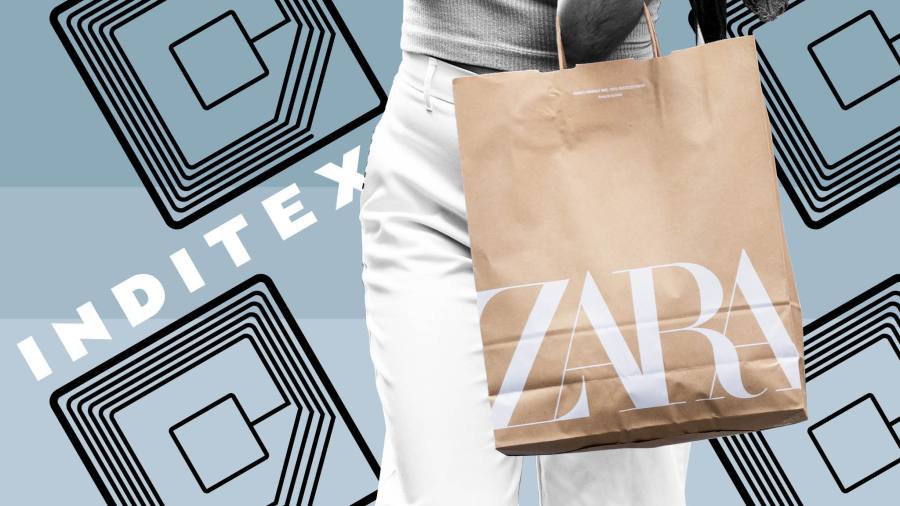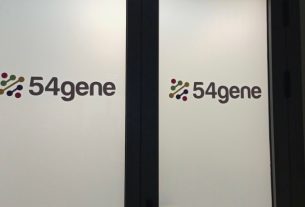[ad_1]
The two silver boxes, about 2 metres in height, look more like dry cleaning units than a big step towards the future of retail. But, as a line of trousers on hangers sways its way through them, it is the start of a tracking system that has helped the world’s biggest clothing seller bounce back from the pandemic.
The process is vital to the success of Inditex, the Spanish fashion group best known for its Zara brand, in capitalising on its network of 6,700 stores across the world — even when they were almost all closed due to Covid curbs.
The task performed at the company’s headquarters by the two boxes, and about 150 others like them throughout the company’s network, is to give unique identifiers to each of the more than 1bn clothes Inditex handles each year, so they can be tracked across the globe until they are in shoppers’ hands.
That has allowed Inditex to turn its stores into mini-distribution hubs — merging its online and bricks and mortar presence, reducing inventories, and helping the company emerge from its biggest test ever since the opening of the first Zara store 46 years ago.
Anne Critchlow, an analyst at Société Générale, says very few retailers have the ability to fulfil online orders in a cost-effective way using the stock found in stores.
“Inditex has the technology to do this: its store network gives it the equivalent of more than 6,000 local warehouses that can ship orders quicker and at less cost because they are so close to customers,” she says.
The tracking technology, known as radio-frequency identification or RFID, depends on tiny circuits and antennas hidden in security tags fastened to clothing in Inditex’s factories. The rollout for the group — which also includes the Massimo Dutti, Pull&Bear and Stradivarius brands — was a decade-long effort completed at the end of 2019, in what looks in retrospect to be perfect timing for the pandemic.
The company only began taking orders for clothing online in 2010 — a decade after H&M. In 2019, online represented just 14 per cent of its €28bn in sales. But last year that proportion jumped to 32 per cent as the group used backrooms in its stores across the world to pack and dispatch €1.2bn of clothing customers ordered on mobiles and computers, in addition to more conventional shipments.

By 2020’s end, Inditex’s online revenues had soared 77 per cent, more than three times the 22 per cent overall rise in the global online clothing and footwear market.
“Since we began our sales online, it has been an obsession with me that it has to be fully integrated with the stores,” says Pablo Isla, executive chair of Inditex, who has headed the company for more than 15 years. “We never wanted to do a separate business online . . . although with [online] sales last year of €6.6bn we are world leaders in online fashion.”
In effect, Inditex is betting the industry’s future rests on a hybrid model that marries bricks and mortar and mobile apps and maintains its commitment to stores, even as many of its rivals close outlets and new online-only retailers mount a formidable challenge with lower prices and a wider range of products.
“Different business models can always be successful in a sector. But ours has a lot of potential and a long way to go,” says Isla. “I don’t believe this stuff about the death of the high street at all.”
The company says one of the reasons why its stores remain so integral to its operations is because they are still the best place to see what works — which clothes people make a beeline for, what products walk off the shelf.

“With the pandemic receding, everyone is trying to recalibrate the balance between the online and the real world and Inditex has invested big in an approach that tries to deliver a seamless experience between the two,” says Critchlow. “Their approach worked fantastically during the pandemic and may reduce costs still further this year, but how it fares over the long term could well shape the future of retail.”
Swift supply chains
In a country where blue-chip companies tend to be in regulated industries — banks or utilities — Inditex stands out for not depending on the government and for having made its own way.
More than anyone else, that way was forged by one man: Amancio Ortega, its reclusive 85-year-old founder. Ortega still owns almost 60 per cent of the stock, making him one of the world’s richest people, with net assets estimated at close to $70bn, mostly held through Pontegadea, his personal investment vehicle, which specialises in prime real estate across the world.
He stepped down as Inditex chair in 2011, focusing on Pontegadea’s investments, but his attention snapped back to the retailer during the crisis, as concern mounted about the business.

“The culture of the company reflects Amancio Ortega’s personality,” says Isla, who says he and Ortega are in “permanent contact”.
Isla remembers watching events in China — where Inditex has 320 stores — and Italy — where it has 350 — with dismay, until the company took a decision on March 9 last year to halt new stock-buying while honouring existing orders. A week later, it wrote off €287m in inventories and suspended dividends. For the three months to the end of April, it reported its first loss as a public company — of €409m.
“For the first two or three weeks we were all in shock, no one was thinking about buying [clothes],” he adds, noting that in the depths of the crisis the company focused on using its freight capacity and logistical knowhow to get medical equipment from China to Spain.
But Inditex was able to get access to its shops from mid-April last year, fulfilling online orders from them, thanks to its tracking system, even while they were closed.

Because of its fast supply chains — just three weeks between design approval and going on sale — Inditex can alter and add to its range in midseason, responding to consumer demand. It churns out 65,000 new designs a year, delivering the latest garments to its network of stores at least twice a week.
The group says its approach is based on “pull” rather than “push”. Inditex does not spend significantly on advertising, but 20m people view its products every day online on its apps or social media. It prefers to buy prime locations for its outlets. Prime real estate — Ortega’s big bet in investing his personal fortune — remains at the heart of what Inditex does.
“The essence of our strategy at Inditex is the same as ever: flexibility in our business model, the integration of logistics, manufacture and design; production close to hand; and a capacity to react from moment to moment,” says Isla.
“But now we have the integration between the digital and physical on top of that . . . 2020 was a key year in the strategic transformation of the company, from every point of view.”
Sustainability pressures
Even amid the turmoil of the past year, the fate of the group’s brick and mortar stores is not the only existential question facing Inditex. It is also having to grapple with criticism over the sustainability of its business model and labour conditions at some of its suppliers.

“Inditex has pioneered a model that is logistically outstanding and has superb, responsive information systems that focus on novelty,” says Carmen Valor Martínez, a sustainable fashion expert at Comillas Pontifical University in Madrid.
“But for the environment this emphasis on the constantly new — clothes you might wear just twice — has been a disaster. To be fair, Inditex has been adjusting its model; but to be sustainable, it’s a model that needs to be broken with, not just tweaked.”
Inditex replies it has steadily increased sustainability — committing to zero waste to landfills and the end of single-use plastics by 2023.
Last week it unveiled more ambitious goals, including to use 25 per cent less water by 2025 and increase revenues from its more sustainable Join Life label to more than half of all sales next year. “It is a total bet on sustainability,” says Isla.
Labour practices are also in the spotlight. This month, French prosecutors opened a probe into Zara and three other fashion brands over the alleged use of forced labour by Muslim minority Uyghurs in China’s Xinjiang province — one of the world’s cotton production centres.
Inditex says it has “zero tolerance for all forms of forced labour” and “rigorous traceability controls” for its supply chain. It does not have factories in Xinjiang. But officials are reluctant to make any statement to that effect. After rival H&M announced last year that it would no longer source cotton from Xinjiang, Chinese state-backed media and social media users launched a mass boycott of the Swedish retailer in March.

Inditex swiftly scrubbed its website of a statement that confirmed it did “not have commercial relations with any factory in Xinjiang” — a move that signals that it, like other multinationals, is vulnerable to pressure from Chinese consumers and the Chinese state.
Intense competition
Inditex’s 700 designers work solely out of its headquarters at Arteixo in the region of Galicia. They say people are hungry for a burst of colour after months of lockdown. One of the styles they are preparing is the “Camden look” — an eclectic mix of the colourful and the classic, mixing wool and cotton, checkered shirts and jeans.
Such calculations have a record of success. Inditex tweaks its offer based on local preferences and information. As of May, it has managed to surpass its 2019 levels of sales, despite remaining restrictions, as customers anticipate the end of the pandemic.
Isla signals optimism that increased profitability may put the group’s share price, which has bumped along below its 2017 peak, on a sustainable upward path. Total capital expenditure is set to dip from its level in recent years — which he says should increase operating cash flow.

The company is still planning significant investments — including €1.7bn on stores and €1bn on technology over three years. But it is winding up a €11bn programme dating back to 2012 and mainly intended to open, refurbish and merge stores while integrating them into the group’s IT system. It is maintaining a goal of increasing gross retail space by 2.5 per cent a year while focusing on bigger, better situated stores.
“These days Inditex is not necessarily a high growth model, but what it increasingly looks like is a gigantic cash generating machine,” says SocGen’s Critchlow.
There are other challenges facing the group. Some 15 per cent of Inditex’s revenues still come from Spain, an economy battered by the pandemic like no other, which means that overall growth will depend on other markets.
Competition is also becoming more intense, not just from rivals but also from online-only groups such as China’s Shein which offer a bigger range of products than physical stores — at lower prices, with a still shorter time between product design and delivery than Inditex’s own supply chain. In an indication of the pressures facing fashion retailers, Gap said last month it would close all its UK stores.
Jacqueline Windsor, a partner in PwC’s UK practice specialising in retail, says: “For an incumbent, Zara is pretty sharp, but the reality is that these disruptive models are going after the clothing wallet.”

She adds: “While it’s true that Zara serves a wider customer market that’s relatively older and more affluent, where sustainable, ethical credentials could be an important advantage, the question is how brave will Inditex be in moving into new areas.”
Windsor contends the word “retail” fails to capture the world where companies such as Inditex now operate — with competition from social media, groups focusing on second-hand clothes and rentals, or online marketplaces that hold no stock of their own.
In Arteixo, Inditex is betting that, for all the changes — accelerated during the pandemic — a big part of the industry will remain familiar: people going to stores and trying clothes on. After 2020’s spike in digital sales, the group expects online to grow more slowly, although steadily, this year and after.
Meanwhile, some online fashion retailers have begun to flirt with bricks and mortar. This week Asos and Boohoo announced partnerships with Nordstrom in the US and Alshaya in the Middle East respectively to sell their labels in physical stores.
“The strategy we are developing — full integration between the physical and the digital, managing the company with even less stock, betting on sustainability — is delivering results,” says Isla, who enthuses about the number of people he saw on a recent trip to the group’s Paris and Milan stores.
But it is also a strategy that looks back to the cautious innovation of Amancio Ortega. The Inditex founder would make relatively few items of clothing and see how they sold before committing more heavily, taking advantage of his group’s vertical integration between manufacturing and retail even when it was at a far smaller scale.
Decades and billions of items of clothing later, Inditex is maintaining Ortega’s emphasis on the importance of real estate and keeping to the basic tenet of his approach: to make what it sells, rather than to sell what it makes.
[ad_2]
Source link



